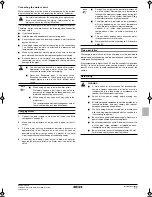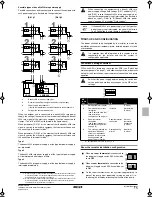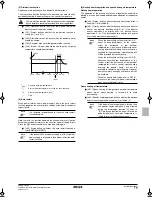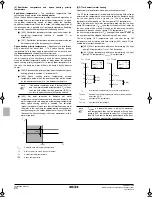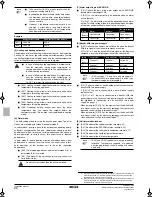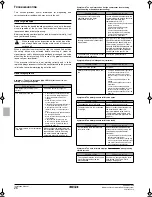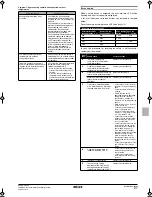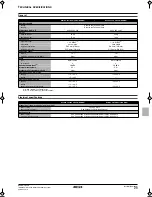
RKHBH/X016AB
Indoor unit for air to water heat pump system
4PW50205-1A
Installation manual
15
Possible types of benefit kWh rate power supply
Possible connections and requirements to connect the equipment to
such power supply are illustrated in the figure below:
When the outdoor unit is connected to a benefit kWh rate power
supply, the voltage free contact of the receiver controlling the benefit
kWh rate signal of the electricity company must be connected to
clamps 17 and 18 of X2M (as illustrated in the figure above).
When parameter [D-01]=1 at the moment that the benefit kWh rate
signal is sent by the electricity company, that contact will open and
the unit will go in forced off mode
(1)
.
When parameter [D-01]=2 at the moment that the benefit kWh rate
signal is sent by the electricity company, that contact will close and
the unit will go in forced off mode
(2)
.
Type 1
The benefit kWh rate power supply is of the type that power supply is
not interrupted.
Type 2
The benefit kWh rate power supply is of the type that power supply
will be interrupted after elapse of time.
Type 3
The benefit kWh rate power supply is of the type that power supply is
interrupted immediately.
S
TART
-
UP
AND
CONFIGURATION
The indoor unit should be configured by the installer to match the
installation environment (outdoor climate, installed options, etc.) and
user expertise.
DIP switch settings overview
DIP switch SS2 is located on the switch box PCB (see "Switch box
main components" on page 7) and allows configuration of domestic
hot water tank installation, room thermostat connection and pump
operation.
Room thermostat installation configuration
1
Benefit kWh rate power supply box
2
Receiver controlling the signal of the electricity company
3
Power supply to outdoor unit
(refer to the installation manual delivered with the outdoor unit)
4
Voltage free contact to indoor unit
(1) When the signal is released again, the voltage free contact will close and the unit
will restart operation. It is therefore important to leave the auto restart function
enabled. Refer to "[3] Auto restart" on page 19.
(2) When the signal is released again, the voltage free contact will open and the unit
will restart operation. It is therefore important to leave the auto restart function
enabled. Refer to "[3] Auto restart" on page 19.
1
2
3
X2M
17 18
X40A
A1P
L N
2
4
1
3
3
*
RHQ
*
KHBH/X
L N
2
1
4
3
4
3
L N
2
1
S2S
S2S
S2S
[D-01]=1
1
2
3
L N
2
1
3
L N
2
1
4
3
4
3
L N
2
1
S2S
S2S
S2S
[D-01]=2
When connecting the equipment to a benefit kWh rate
power supply, change field settings [D-01] and both [D-01]
and [D-00] in case the benefit kWh rate power supply is of
the type that power supply is not interrupted (like illustrated
above as type 1). Refer to "[D] Benefit kWh rate power
supply" on page 22 of chapter "Field settings".
NOTE
If the benefit kWh rate power supply is of the type that
power supply is not interrupted, the unit will be forced
to off. Controlling the solar pump is still possible.
It is important that all information in this chapter is read
sequentially by the installer and that the system is
configured as applicable.
Switch off the power supply before opening the switch box
service panel and making any changes to the DIP switch
settings.
DIP
switch
SS2
Description
ON
OFF
1
Not applicable for installer
—
(Default)
2
Domestic hot water tank
installation
(see "Domestic hot water
tank installation
configuration" on page 16)
Installed
Not installed
(Default)
3
Room thermostat
connection
(see "Room thermostat
installation configuration"
on page 15)
Room thermostat
connected
No room
thermostat
connected
(Default)
4
This setting
(a)
decides the
operation mode when
there is a simultaneous
demand for more space
heating/cooling and
domestic water heating.
(a) only applicable in case DIP switch 2 = ON
Heating/cooling
priority
No priority
(Default)
■
When no room thermostat is connected to
the indoor unit, toggle switch SS2-3 should be
set to OFF.
■
When a room thermostat is connected to the
indoor unit, toggle switch SS2-3 should be set
to ON.
■
On the room thermostat, set the hysteresis appropriately to
prevent the pump from repeatedly turning on and off (i.e.
chattering), and thereby impacting the lifetime of the pump.
4
3
2
1
ON
OFF
4
3
2
1
ON
OFF
4
3
2
1
ON
OFF
1D_IM_4PW50205-1A.book Page 15 Thursday, January 29, 2009 12:00 PM











